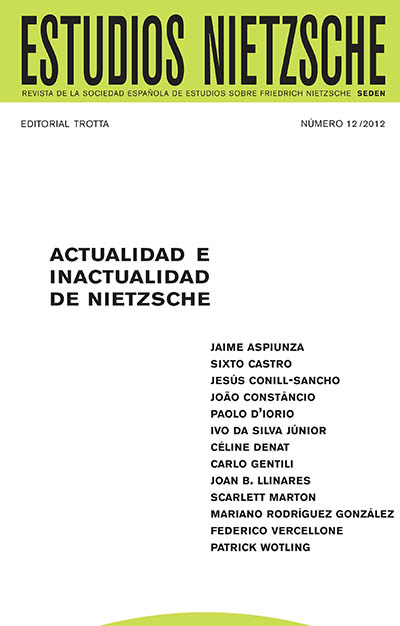Nietzsche and the Image. Has the real world become in a fable?
DOI:
https://doi.org/10.24310/EstudiosNIETen.vi12.10562Keywords:
image, perspective, will to powerAbstract
In this text Nietzsche’s concept of image is presented as it evolved with the development of his philosophy. In his early writings, particularly in The Birth of the Tragedy, what comes out is the image which is conceived as an artistic symbol, as an expression of nature and not as a representation of the world. If we consider the development of Nietzsche’s thought, we can see that in the last period we have instead a conception of the
image that depends on the idea of perspective, with a kind of image which is conceived as a representation. Image as a representation has lost every positive relationship to the world and is an important factor in the «will to power». The image now coincides with the Hegelian «end of art».
Downloads
Metrics
References
Belting, H., Florenz und Bagdad. Eine westostliche Geschichte des Blicks, München: Beck, 2008.
Gentili, C., «'Morte dell'arte' e 'Morte di Dio'. Confronti testuali e relazioni concettua- li», en M. C. Fornari (ed.), Nietzsche. Edizioni e interpretazioni, Pisa: ETS, 2006, pp. 179-192.
Nietzsche, F., Obras Completas, I-IV (OC ). Director ed. Diego Sánchez Meca. Madrid: Tecnos, 2011-2016
Nietzsche, F., Correspondencia I-VI. (CO). Director ed. Luis E. de Santiago Guervós. Madrid : Trotta, 2005- 2012.
Nietzsche, F., Fragmentos Póstumos I-IV (FP). Director ed. Diego Sánchez Meca. Madrid: Tecnos, 2006-2010.
Vattimo, G., Il soggetto e la maschera. Nietzsche e il problema della liberazione, Milano: Bompiani, 1974.
Downloads
Published
How to Cite
Issue
Section
License
As of issue 21 (2021) this journal is published only in open access (diamond route).
From that number 21, like the previous numbers published in NIETZSCHE STUDIES, they are subject to the Creative Commons Acknowledgment-NoComercia-ShareIgual 4.0 license, the full text of which can be consulted at <http://creativecommons.org/licenses/by-nc-sa/4.0 >
It is the responsibility of the authors to obtain the necessary permissions of the images that are subject to copyright.
This work is licensed under a Creative Commons Attribution-NonCommercial-ShareAlike 4.0 International License.
Copyright generates two different rights: moral rights and patrimonial rights that EJFB recognizes and respects. Moral rights are those relating to the recognition of the authorship. They are rights of a personal nature that are perpetual, inalienable, unseizable and imprescriptible as consequence of the indivisible union of the author and his/her work.
Patrimonial rights are those that can be derived from the reproduction, distribution, adaptation or communication of the work, among others.







11.png)
